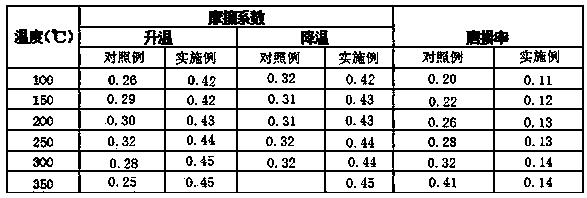Reinforced type aluminum-copper-based composite friction material
A composite friction material, aluminum-copper-based technology, applied in other chemical processes, chemical instruments and methods, etc., can solve the problems of noise and vibration service life, high noise of steel brake pads, lack of scientific design, etc., to reduce thermal expansion. coefficient, improve wear resistance, reduce the effect of high temperature thermal recession
- Summary
- Abstract
- Description
- Claims
- Application Information
AI Technical Summary
Problems solved by technology
Method used
Image
Examples
Embodiment 1
[0008] An enhanced aluminum-copper-based composite friction material, which is made of raw materials through mixing, hot pressing (200-250Mpa, 8-10 minutes) and curing process (350-380 degrees Celsius solid solution for 3-4 hours, water cooling, 220-240 Celsius solution-aging treatment for 7-8 hours), the raw materials include 15 parts by weight of cast aluminum alloy ZAlSi8MgBe powder, 10 parts by weight of copper alloy Cu30Ni15Mn powder, 10 parts by weight of silicon carbide, and 6 parts by weight of potassium titanate fiber, 6 parts by weight of aramid fibers, 6 parts by weight of zirconia, 3 parts by weight of tetrapod zinc oxide whiskers, 2 parts by weight of molybdenum disulfide, 2 parts by weight of barium sulfate, 2 parts by weight of tungsten carbide, 1.5 parts by weight 1 part of nitrile rubber, 1 part by weight of nano-titanium dioxide; the particle size of silicon carbide is 10 μm, the length of potassium titanate fiber is 18 μm, the length of aramid fiber is 2 mm, ...
Embodiment 2
[0010] An enhanced aluminum-copper-based composite friction material is made of raw materials through mixing, hot pressing and curing processes. The raw materials include 20 parts by weight of cast aluminum alloy ZAlSi8MgBe powder, 10 parts by weight of copper alloy Cu30Ni15Mn powder, 8 parts by weight Parts of silicon carbide, 8 parts by weight of potassium titanate fiber, 5 parts by weight of aramid fiber, 5 parts by weight of zirconia, 4 parts by weight of tetrapod zinc oxide whiskers, 1 part by weight of molybdenum disulfide, 2 parts by weight Parts of barium sulfate, 1 part by weight of tungsten carbide, 2 parts by weight of nitrile rubber, 2 parts by weight of nano-titanium dioxide; the particle size of silicon carbide is 12 μm, the length of potassium titanate fiber is 16 μm, the length of aramid fiber is 2.5 mm, monofilament The diameter is 8 μm, the length of the four needle-shaped zinc oxide whiskers is 10 μm, the root diameter is 1.5 μm, the particle size of zirconia...
Embodiment 3
[0012] An enhanced aluminum-copper-based composite friction material is made of raw materials through mixing, hot-press forming and curing processes. The raw materials include 25 parts by weight of cast aluminum alloy ZAlSi8MgBe powder, 8 parts by weight of copper alloy Cu30Ni15Mn powder, 9 parts by weight Parts of silicon carbide, 7 parts by weight of potassium titanate fiber, 5 parts by weight of aramid fiber, 6 parts by weight of zirconia, 4 parts by weight of tetrapod zinc oxide whiskers, 1 part by weight of molybdenum disulfide, 2 parts by weight Parts of barium sulfate, 2 parts by weight of tungsten carbide, 1.5 parts by weight of nitrile rubber, and 1 part by weight of nano-titanium dioxide. The particle size of silicon carbide is 12 μm, the length of potassium titanate fiber is 16 μm, the length of aramid fiber is 2.5 mm, the diameter of monofilament is 8 μm, the length of four needle-shaped zinc oxide whiskers is 10 μm, and the diameter of root is 1.5 μm The diameter ...
PUM
| Property | Measurement | Unit |
|---|---|---|
| particle diameter | aaaaa | aaaaa |
| length | aaaaa | aaaaa |
| diameter | aaaaa | aaaaa |
Abstract
Description
Claims
Application Information
 Login to View More
Login to View More - R&D
- Intellectual Property
- Life Sciences
- Materials
- Tech Scout
- Unparalleled Data Quality
- Higher Quality Content
- 60% Fewer Hallucinations
Browse by: Latest US Patents, China's latest patents, Technical Efficacy Thesaurus, Application Domain, Technology Topic, Popular Technical Reports.
© 2025 PatSnap. All rights reserved.Legal|Privacy policy|Modern Slavery Act Transparency Statement|Sitemap|About US| Contact US: help@patsnap.com

